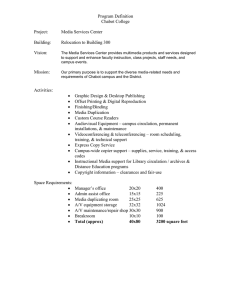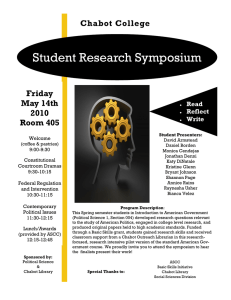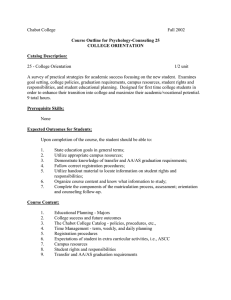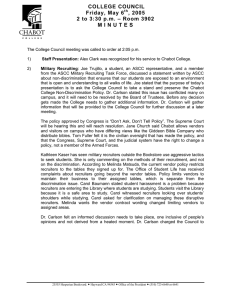College Council Friday, September 16 , 2005 2 p.m.
advertisement
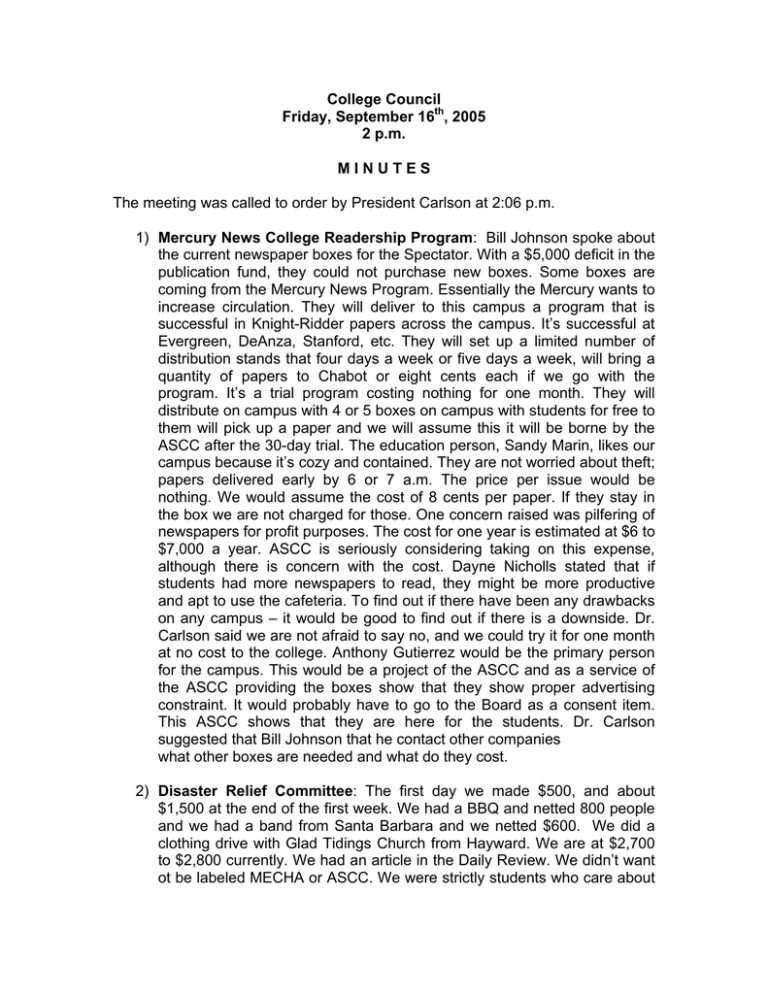
College Council Friday, September 16th, 2005 2 p.m. MINUTES The meeting was called to order by President Carlson at 2:06 p.m. 1) Mercury News College Readership Program: Bill Johnson spoke about the current newspaper boxes for the Spectator. With a $5,000 deficit in the publication fund, they could not purchase new boxes. Some boxes are coming from the Mercury News Program. Essentially the Mercury wants to increase circulation. They will deliver to this campus a program that is successful in Knight-Ridder papers across the campus. It’s successful at Evergreen, DeAnza, Stanford, etc. They will set up a limited number of distribution stands that four days a week or five days a week, will bring a quantity of papers to Chabot or eight cents each if we go with the program. It’s a trial program costing nothing for one month. They will distribute on campus with 4 or 5 boxes on campus with students for free to them will pick up a paper and we will assume this it will be borne by the ASCC after the 30-day trial. The education person, Sandy Marin, likes our campus because it’s cozy and contained. They are not worried about theft; papers delivered early by 6 or 7 a.m. The price per issue would be nothing. We would assume the cost of 8 cents per paper. If they stay in the box we are not charged for those. One concern raised was pilfering of newspapers for profit purposes. The cost for one year is estimated at $6 to $7,000 a year. ASCC is seriously considering taking on this expense, although there is concern with the cost. Dayne Nicholls stated that if students had more newspapers to read, they might be more productive and apt to use the cafeteria. To find out if there have been any drawbacks on any campus – it would be good to find out if there is a downside. Dr. Carlson said we are not afraid to say no, and we could try it for one month at no cost to the college. Anthony Gutierrez would be the primary person for the campus. This would be a project of the ASCC and as a service of the ASCC providing the boxes show that they show proper advertising constraint. It would probably have to go to the Board as a consent item. This ASCC shows that they are here for the students. Dr. Carlson suggested that Bill Johnson that he contact other companies what other boxes are needed and what do they cost. 2) Disaster Relief Committee: The first day we made $500, and about $1,500 at the end of the first week. We had a BBQ and netted 800 people and we had a band from Santa Barbara and we netted $600. We did a clothing drive with Glad Tidings Church from Hayward. We are at $2,700 to $2,800 currently. We had an article in the Daily Review. We didn’t want ot be labeled MECHA or ASCC. We were strictly students who care about what is going on. It was confusing for some, so we labeled ourselves the Disaster Relief Committee. We want to use that money that we collected to donate to three different charities on behalf of Chabot. I am here to get your permission. The charities Red Cross, Direct Relief, and People’s Committee Out of Massachusetts (they are a group who have direct connection with people in Louisiana and give money and clothing handson. Some of the concerns to look at include accountability, funds go directly to those who are affected, etc. I was faced with a lot of opposition leaning towards the BBQ. Being a student leader at Chabot, it was a question blow. We weren’t allowed to do it on Thursday, it was unjust and not fair. Without Melinda, Bob Curry, and Bob Carlson, we couldn’t have pulled it off. Students should not have to face that opposition or stress that I go through as a student. Dr. Carlson doesn’t think you need permission to send the money that was raised. You raised it, and you have the choices. Nacho wanted to thank Dr. Carlson with his support and help. Dr. Carlson commended Nacho for taking a leadership role and recognized him for his taking a stance and putting this on. It was a great idea. Some of the bureaurcracy exists for a reason. 3) RFP Process: Bob Curry reported that a committee of ten students, staff, faculty, and administrators have met and have begun the review process for the Food Service Selection Committee. The RFP is going to the Board of Trustees meeting on Tuesday, September 20th, 2005 for approval to proceed, and a deadline to submit a bid is October 21st. The evaluation process will take place in late October to early November, and the Board will select the new vendor at their meeting on Tuesday, December 13th. The first day of service will be January 22nd, 2006. 4) Strategic Plan Input (Sally Jahnke): Sally spoke about the IPBC and the development of a new strategic plan during September and October 2005. We will develop a 3-year plan for 06-09 and a one year plan for 06-07. We have been using several avenues to gain background information and ideas for our process, so the plan we develop will reflect the needs of the College as seen by a broad constituency. Sally asked the College Council to record their responses to five questions: what are the new and emerging areas and needs that you see in the next 15 years that the College will need to respond to; what are the problems the college needs to resolve; what are things the college needs to do to recover from its financial condition; what are the areas where the college needs to improve; and what else is important to achieve in the next 15 years? Council members shared their responses. Some issues discussed included parking, inaccessible public transportation to the campus (suggestion made to share shuttle with CSUEB); high cost of textbooks; quarter system vs. semester system; ineffective college website; internal view of Chabot as “Hesperian High School” (not necessarily known in the external community); traffic problems; start classes later in the day (to help alleviate traffic and parking problems); widening curriculum and programs to include new hobbies that are turning into careers; incorporate Email more in daily college activities and classes; increase on-line courses (i.e., Distance Ed and classes in other languages); clear understanding of the governance structure; need to provide written policies/procedures for new staff; more help with speakers of other languages; Strategic Cost Management process – how will that be implemented; trends – people’s expectations of having things on demand (i.e,. Education – how is it needed, flexible schedules, shorter terms, providing education on demand); people’s needs for retraining for jobs that might pay something – how do we respond to occupational training needs and increase degree programs to help community meet those needs; meeting the college deficit – evaluate the current programs and services departments provide – are we being a full-service college?; shared purpose across the campus – vision – disseminate it out to everyone; increase communication campus wide; renovation process (Measure B) – how do we do that without losing students – how do we maintain our level of services without inconveniencing students; fastest growing segment needing training are recent immigrants or children of recent immigrants, according to a local area economist – we need to address this; we need to improve our process for becoming a learning-centered college; financial and sociological – need better district and college fiscal relationships – and with LPC; the colleges have an I attitude and is behavioral; district has a you attitude and we don’t have a we attitude – need fundamental change in behavior that needs to start at the top; we can’t resolve problems until this change takes place; we have to redefine our role and responsibilities to the community – we have to constantly redefine it and how we do this through vocational and occupational training; we need better industry partnerships; we need to continue to improve our image in the community; within that we need to continue to look at reinforcing what we are doing and run the gamut of our service area and the needs of the whole community and not just one community; assessment – there is a need to better assess students (i.e., problem identified about Machine Tool Technology not being effectively assessed); everyone needs to be assessed, including Math and English – it will help us understand how we can better serve our students and community; we have duplications of effort, LPC, within Chabot (i.e., inventory vs. construction); our students are now registering on line in large numbers – but when they get done, they have to stay in line at the Bookstore for many hours – why can’t they buy the books at the Bookstore and have them shipped; the bottleneck is the opening of the door; the new software program to be implemented this Spring will be tied into Banner that will help students purchase books on line and have them shipped; Mike mentioned assessment of students – - we don’t assess students very well, but we don’t assess our own operations very well; how can and do we work on process improvement if we don’t assess our own operations and looks at our own institution; collecting data and the other half is taking that data and assessing it effectively to improve us; purchasing system – one of the targets for improvement – we need a credit card system to be implemented; some colleges have rolling curriculum that can be started on any particular day of the week; webpage – we have a marketing meeting a few day sago and we talked about doing something with the web page; Dr. Carlson said he has difficult navigating his way through the Chabot web page and he is a novice, but he feels if he can’t do it, a lot of others can’t do it; the web page takes too much time to read; the state of the college will change over the next decade due to the bond measure; KH stuff – reminder today that we passed out things at the last administrative staff meeting – we were going to get off this week to do some thinking – be prepared next Friday, 9/23 to converse about what you see at the KH data – must be ready to converse – read the documents; RE: Hesperian High – Dr. Carlson said he came here four years ago and he has never heard that in the community; it’s an image that doesn’t exist; Thank you, Sally, for implementing this project. 5) Proposed Tuition Increase for the Children’s Center: The Center currently serves 125 children in the day program and 50 children in the evening program. I have requested an increase of $100 a month per child. We last did this 1-1/2 years ago. This increase will not be passed on to those who are receiving subsidized care. State rates will be $19 per child per day for children attending part-time less than 6 hours a day; full-time it will be $24. per child per day at 226 days a year. 125 children total and there are 13 families currently paying tuition; About 90% are now subsidized. Dr. Carlson asked why don’t we include less subsidized families and include more who can pay the full price; suppose we make it $225 a week, and ask those on subsidized programs to pay the difference; subsidized children have to fall into an income range less than a certain amount of money to qualify; we would lose a lot of children; it’s hard to find head start children due to the income level that is required; their income is so low that they couldn’t come up with the difference; do you turn away individuals who can pay – they do we get state funding and head start funding for one children; the tuition family is paying full price; the proposed increase will only affect 13 families; the hourly rate only pertains to evening children who pay by the hour; the enrollment fee might scare some people away, but it takes over two hours to enroll one child; the day program will stop at 4, and the evening program starts at 5. 6) Institutional Research – Student Survey Topics – Dr. Arnold reviewed the draft questions and asked the Council for feedback; topics include financial aid – have people applied for it and if not, why not; will the information be used and how? If there are scheduling changes due to construction – asking students telling them if we have to move morning classes, how many would be able or willing to take classes at different times? We might lose students as a result. Council suggested that “we will be moving classes due to construction; what hours will you be willing to take for classes? Would you take a class in 2 or 3-hour blocks? Textbook sources – would it be useful to know if students get their books on line or how do students get their books? If you were able to buy your textbooks on line through Chabot, would you? Have you bought your textbooks on line from the Chabot Bookstore is the question that was suggested. Have you bought on line from someone besides Chabot? Transportation – is the issue of free Bart shuttle still alive? 7) Other Business: SLOACS Steering Committee has started and is meeting on Room 1102, Tuesday, September 27th at College Hour. 8) Searching Intranet and Internet – there is nothing on Program Review on the intranet and internet – Chad Mark Glen stated. Tom DeWit has been asked to put the Program Review on there, and Dr. Carlson will ask Bella to ensure that Program Review is included on the website. 9) Tom Clark said some committees are posting minutes on the intranet site and some are posting on the internet site; it is not consistent, and it is creating confusion. The issue is Bella is supposed to keep nagging and organize so all minutes are on the intranet for review; she needs to provide consistent follow-up with governance groups. 10) Jane Church – Sadie Ashraft has volunteered to take on the international counseling role –0 she has met with key people on campus, and is reaching out to other colleges to learn about their international student program; we want to include activities that we can accomplishing within our budget this year for international students. We have been missing a counselor dedicated to international students. Sadie also has additional roles and responsibilities. 11) Dr. Carlson wanted to meet presidents and chairs of all the governance groups – my original goal for governance was to have these committees be formed in April, meet in May once, then in August start their work. This hasn’t gotten done or accomplished last Spring; my goal was through Convocation to get the committees together. We don’t know the committee make-up, we don’t know if the committees are meeting, nor do we know what is going on with them. We want to review the consent model to reach decisions. I am at lost with our governance structure. We need to get it done in Spring 2006, and if not, we will form a meeting at Convocation 2006. I need to know now and a list of who are the members and they are represented. Provide the information from each committee, who is chairing it, when is the meeting, and all the basic stuff. Until you provide me with something, I will know it then. Karen will collect it over the next week, and Bella will correlate the information with the website to see what is and isn’t missing. I appreciate that Rachel Ugale and Chad Mark Glen are on top of it, but because the communication is not there and I haven’t been involved, I need to know. Dr. Arnold said staff may not be aware that these committee websites exist, and we need to include a communication to staff. We need to include a weekly meeting calendar that advises staff about upcoming week-long meetings so they know what governance groups are meeting week by week. The Hayward Chamber weekly Email posts a 10-day forecast that advises the community about upcoming events. Can you sort me out so I can get the websites right so we can disseminate information to staff about committees. 12) Homecoming – if you can come to the Homecoming, try to come and attend. A lot of people have done a lot of hard work The meeting adjourned at 4:27 p.m.
